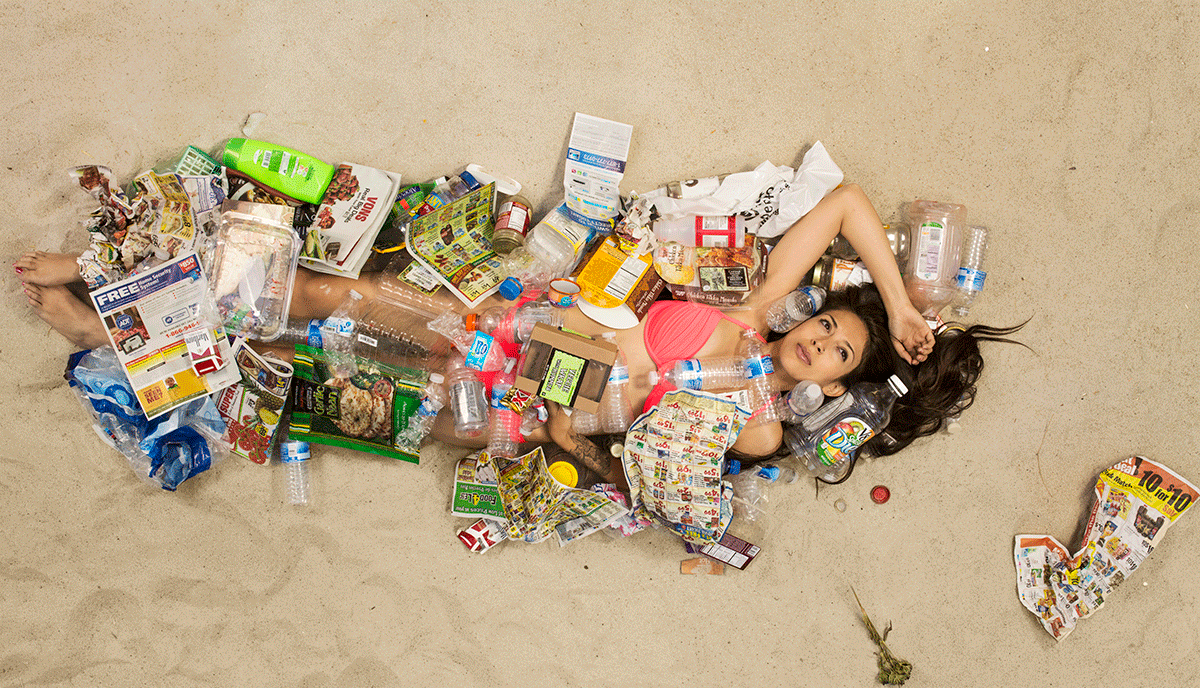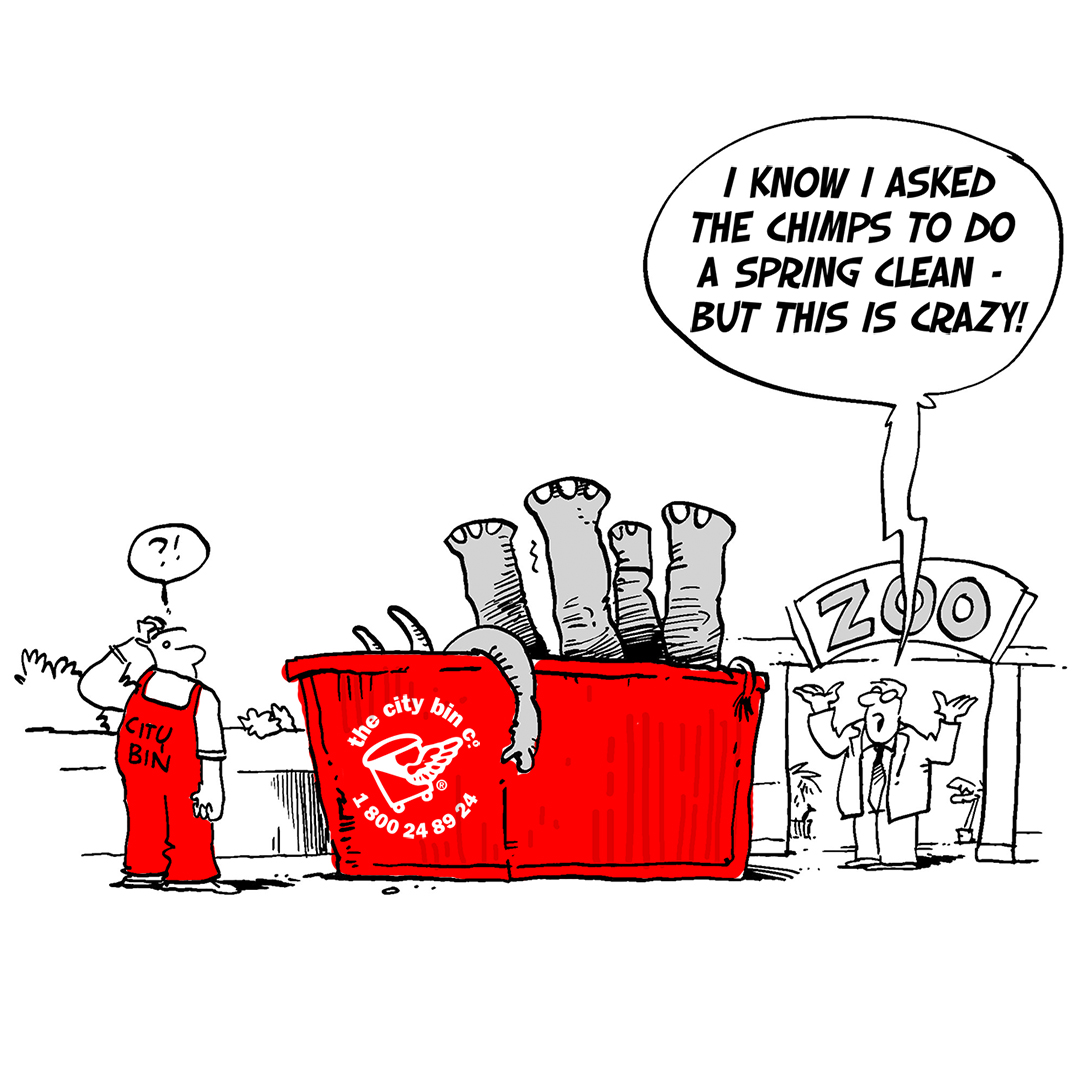When Rubbish Becomes Art

Could you imagine relaxing in seven days of your own rubbish?
Well, that’s just what Gregg Segal’s Californian neighbours, friends and strangers did! They rested in piles of their own rubbish that they collected over a period of seven days for Gregg’s photography series entitled ‘7 Days of Garbage’. Fitting that this series of life-size portraits now adorn the walls of The City Bin Co.’s offices, both in Dublin and the HQ in Galway – as a stark reminder of the dangers of a throwaway society.

Segal’s photography makes you sit up and think because the content seems so contradictory. The small volume of waste becomes big over time – imagine a month’s worth? A year? The ugliness of the waste collected over time becomes striking in the composition. You see the unnatural materials against the natural human body. The rubbish becomes art.

The photographs are a visual index of the waste that we, as humans, produce over time. It shows our changing diet patterns and the volume of packaging we seem to need to feel good about what we purchase and consume. The images were headlined in some news outlets as shocking, but we believe they are inspiring and thought-provoking. These photos deliver real statistics with a visual impact.
A Skip Story
Many moons ago, when I finished studying Fine Art in Sligo IT, I decided to move back to Galway and live with my parents again…
There was one problem! I left home with one suitcase and came back with a van load of personal belongings which included a bicycle, guitars, a mattress, paintings and countless other items which were probably ready to be placed in a skip. I didn’t want to let go! As there was no space in the house, I decided to store my belongings in my parent’s sizeable shed at the back of the garden. I thought since nobody really uses the shed, it would be prefect to store my baggage! I opened the door to be greeted by a full shed of belongings which had been gathering dust for the best part of 20 years, except my father’s lawnmower which was used twice monthly to trim the garden. There was no space. Not an inch!
Looking for a solution, I decided to hire a skip and give my parents the gift of a clean and tidy shed, albeit one that would double up as storage unit for my belongings for a short time. When I contacted the waste management company, The City Bin Co., to hire a skip I wasn’t sure which size skip would be best for the job, but their customer centre was really informative and explained all the different skip sizes. After all, the shed was full to the brim. You have small skips, medium skips and large skips. Really, there are skips of all sizes for different uses. I decided to hire a medium size skip and if I needed to hire a second skip I could do that.
The skip itself arrived on a sunny Saturday morning and I opened the shed door and started the clear-out. There was a lot of broken furniture, old toys, empty containers, unused bikes, pieces of wood and a small sofa. It took me a good half day to fill the skip and clean out the shed. I even gave it a lick of paint. There were definitely a few upsides to hiring a skip and doing a clean-out that I didn’t expect.
- My mother always said that a tidy home is a tidy mind, and this is so true when it comes to clutter and junk. After I cleaned out the shed, you could actually park a car in it. There was so much room.
- They say exercise the body and the mind will follow. My arms were sore after all the lifting and throwing. It was a good workout and I slept like a baby that night.
- Letting go of unwanted items creates space for new hobbies. In my father’s case, his shed is used more often now as it’s where he stores his gardening tools and keeps his top-soil and pots.
It was a great idea to hire a skip and clean out the shed and to do something useful that would benefit others. However, I do remember, a year after I had hired the skip and cleared out the shed, my father asking me if I had seen the 50-year-old ‘high nelly’ bicycle he used to have.! It was my Homer Simpson moment! “D’oh!” Yes! It went into the skip.

DIY Pizza Oven – Weekend Project

Fancy yourself as the next Jamie Oliver, casually knocking up the perfect pizza in your outdoor pizza oven? Us too! But while we can’t help with the cooking skills, we can help with the DIY skills involved in creating the perfect upcycled pizza oven. Our colleague Eimhin takes us through the process he used for his project. Buon Appetito!
What you will need:
– Vermiculite
– Fire Bricks (we used ones from an old storage heater)
– 2 crates
– A board to go over crates
– Exercise ball
– Chimney pipe (we used an old truck exhaust)
– Hammer
– Perlite
– Portland cement
– Chicken wire
– Formica
– Pavers
An important element to think about before you start building is where you want to site your oven. Unlike a BBQ, you can’t move your pizza oven once it’s built. Choose a spacious well-ventilated area where there are no flammable objects like plants, home heating oil tanks, or bins.
Step 1: Top dome mould build

The exercise ball should have its diameter written on it or on the packaging it came in, mine was 96 centimetres. You will need a table or wooden surface to use as the pizza oven base, we used a piece of scrap wood from the garage.
Cut out your circle (sand down the timber before inserting the gym ball to prevent it puncturing) insert the ball so that an upper hemisphere is jammed into the wood securely keeping the air valve facing down to the ground (once inserted inflate more if needed until the ball is wedged), and your dome is created. You will need to place timber under the ball in order to keep it still, I placed an old beer keg under my one.
Then we moved onto the door mouth entrance. Measure your dome height (ours was 12.5 inches) and choose a door height that is not quite as high (we went with a door height of 7.8 inches). Take your time with making the mould, you want to get these details correct.
Once you think your mould is ready, cover the top half of the gym ball and the oven door with food wrap to stop the vermiculite cement mortar from sticking permanently.

Step 2: Mould the Chicken Wire
Being careful not to puncture the ball, shape the chicken wire around the mould, by doing this now it makes it easier to attach it when doing the concrete.
Step 3: Make the concrete mix
To make the vermiculite cement mortar, use a plastic plant pot or small bucket to measure out 6 parts vermiculite and 1-part cement. Begin to add water slowly. You don’t want a watery slurry, but mouldable clumps. If you add too much water, you can always throw more dry mix in. treat this mix like a sponge cake as the air pockets are very important for the heat value, do not use a cement mixer as this will knock out the air.

Add in your ‘chimney’ part, we used an old waste truck exhaust from a truck.
Start adding the first layer of vermiculite cement mixture to the sides of the gym ball and the mouth structure of the oven with your hands, clump by clump. When the first layer is complete, add a further layer until the dome is about 20-30mm thick.
Add the chicken wire reinforcement There is no need to let the first layer dry before you begin the second layer.
Step 4: Finish detail on the Dome top


Once your concrete has hardened (mine took 24 hours) you can remove whatever support you were using to keep the exercise ball in pace (we used a keg), you will need to deflate the exercise ball to get it out from under the mould. You can also remove the oven mouth support structure.
Now you should be left with your pizza oven dome structure, looking something like what we have below.
Step 5: Firebrick Floor
So, the top of the oven is done. Now it is time to work on the bottom. For the firebrick floor, we used firebricks from an old storage heater.
It is important to lay your brick floor in a herringbone pattern. Reason being if you lay your bricks parallel to the door, when you slide your pizza in you run the risk of catching or chipping a front brick edge.
I slid the top dome onto a piece of plywood, traced it out, then took my original circle cut out that I cut out for the exercise ball (giving me the inside circle of the dome) and had my two templates.
We also added some pavers for the oven to sit on.
I then mixed up a small batch of Portland cement and SS needles and trowelled on a thin coat on the floor base. I basically used it as a “glue” for the two pieces.
We then brought over the top and carefully put on the dowels or supports that you’re using spanning to the bricks. We then aligned it and lifted the rear, slid out the dowel and carefully lowered. Then did it in the front.
Then once they are aligned it was just a skim coat around the outside to seal the seam.
We would recommend waiting a couple of weeks before you get your pizza oven fired up to ensure it is good and cured. If you are unsure, just stick your face in the door and smell. If it smells damp or wet get it a few more days.
Step 6: ‘Curing’ the Oven
To fire cure the pizza oven, start small… do not put a roaring fire in there right away!
After 3 weeks we plan to do a small fire (2-3 twigs) let them burn completely and die out.
Then repeat the next day with a medium fire (3-4 twigs) burn and die out.
Then another medium fire… but add to it to keep it at a medium fire for an hour or so
Then another medium to larger fire, burn for an hour…
Then you should be ready for a nice roaring fire.
Finally…
Time for pizza!